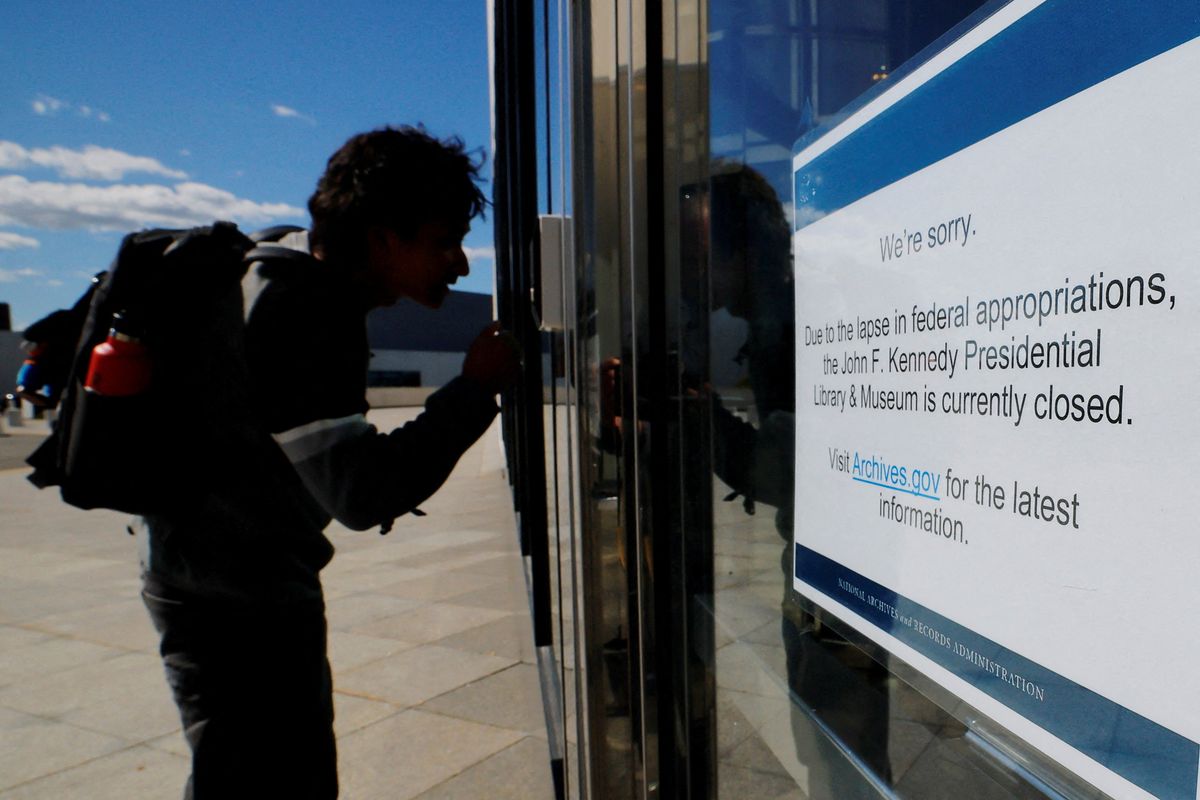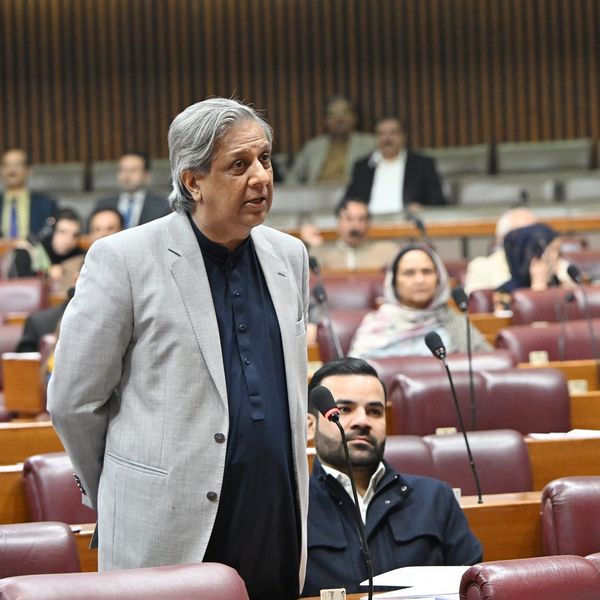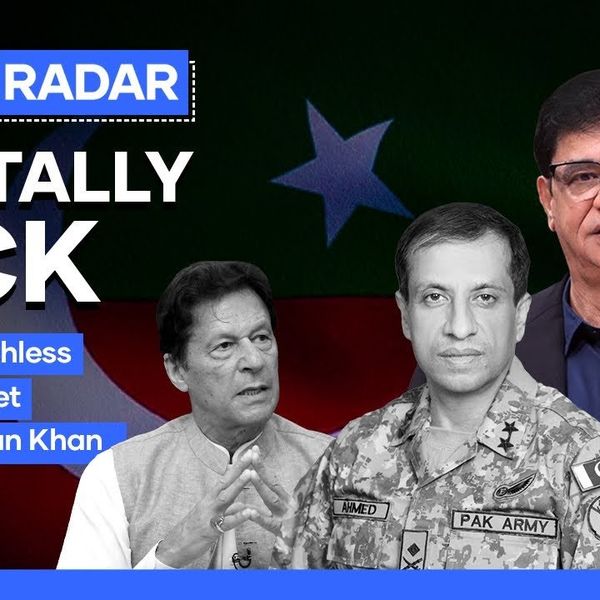Explainer: What US govt shutdown means?
While a shutdown doesn't stop all administrative functions, it is still set to impact millions of workers and US citizens who rely on government support
Abdul Moiz

A man looks into the John F. Kennedy Presidential Library and Museum which is closed, on the first day of a US government shutdown, in Boston, Massachusetts
Reuters
The US government shut down much of its operations on Wednesday as deep partisan divisions prevented Congress and the White House from reaching a funding deal, setting off what could be a long, grueling standoff that could lead to the loss of thousands of federal jobs.
Washington goes into a shutdown when Republicans and Democrats in Congress fail to pass a bill to fund federal operations. With funding stopped, federal agencies are forced to halt non-essential activities.
According to Wells Fargo, a US government shutdown only impacts the 25% or so of federal spending that is characterized as “discretionary”. Programs such as Social Security, Medicare, and Medicaid, categorized as "mandatory" spending, continue unaffected.
The most recent shutdown commenced hours after the Senate rejected a short-term spending measure that would have kept government operations afloat through November 21. Democrats opposed the legislation because Republicans refused to attach an extension of health benefits for millions of Americans, which are set to expire at the end of the year. Republicans say the issue must be addressed separately.
Currently, US President Donald Trump's party, Republicans, holds majorities in both chambers of Congress, but legislative rules require 60 of the 100 senators to agree on spending legislation. That means that at least seven Democrats are needed to pass a funding bill.
Independent analysts warn the shutdown could last longer than the budget-related closures of the past, with Trump and White House officials threatening to punish Democrats with cuts to government programs and the federal payroll.
What caused the shutdown?
Democrats are under pressure from their frustrated supporters to score a rare victory ahead of the 2026 midterm elections that will determine control of Congress for the final two years of Trump's term.
The healthcare push has given them a chance to unite behind an issue that resonates with voters.
Along with the extended health subsidies, Democrats have also sought to ensure that Trump will not be able to undo those changes if they are signed into law. Trump has refused to spend billions of dollars approved by Congress, prompting some Democrats to question why they should vote for any spending legislation at all.
Effects of shutdown
Some 750,000 federal workers were ordered not to work, while others, such as troops and Border Patrol agents, began to work without pay. The Department of Veterans Affairs said it would provide burials at national cemeteries, but would not erect headstones or mow the grass.
The Trump administration has already started stopping federal funding to states ruled by Democrats and projects championed by the party.
Washington has frozen $18 billion for New York and $8 billion in green-energy projects in Democratic states.
Separately, the US Department of Energy on Wednesday said it planned to cancel $7.56 billion in financing for hundreds of energy projects that it said would not provide sufficient returns to taxpayers.
The department's announcement came hours after White House budget director Russell Vought said in a post on X that the administration would terminate nearly $8 billion in climate-related funding in 16 Democratic-led states, including California and New York.
Earlier, Bloomberg reported that the planned cancellations included funding for proposed hydrogen hubs in California and the Pacific Northwest.
California Governor Gavin Newsom, a Democrat, criticized the administration for canceling its $1.2 billion commitment to fund his state's hydrogen hub.
"We'll continue to pursue an all-of-the-above clean energy strategy that powers our future and cleans the air, no matter what DC tries to dictate," Newsom said in a statement.
The Trump administration on Wednesday froze $26 billion for Democratic-leaning states.
The targeted programs included $18 billion for transit projects in New York, home to Congress's top two Democrats, and $8 billion for green-energy projects in 16 Democratic-run states, including California and Illinois.
Vice President JD Vance, meanwhile, warned that the administration might extend its purge of federal workers if the shutdown lasts more than a few days.
The shutdown will also halt some payments to farmers and delay access to federal farm loans.
On Wednesday, the scope of the shutdown's potential impact on US farmers was beginning to emerge. Even short interruptions in payments could deepen farmers' economic turmoil.
Farmers already have significant economic concerns this autumn. Trump's trade war with China has prompted the world's top soybean buyer to shun US shipments for rival Brazil. Moreover, record-high corn harvests are expected to drive down prices, and the costs of farming necessities like seeds and fertilizer are surging.
Now, the US Department of Agriculture has stopped issuing weather-related disaster payments, accepting and processing farm loans, providing technical assistance for conservation programs and swaths of other agency work, the agency shutdown plan said.
It will also not process annual commodity and land conservation payments, typically issued by or in October, or advance money for loans the agency has already approved, according to the plan.
Past US government shutdowns
The longest shutdown on record started December 22, 2018, during President Donald Trump's first term in the White House. Democrats in Congress refused to back a spending bill that included Trump's $5.7 billion request for fencing on the US-Mexico border.
Lawmakers eventually approved a spending bill without border wall money that Trump signed into law on January 25, 2019, ending the shutdown.
1995-1996 - 22 days
The government partially shut down on December 16, 1995, as part of a clash between the Republican-controlled Congress and then-President Bill Clinton, a Democrat, over how to balance the budget. Clinton signed a bill to reopen the government on January 6, 1996. Some polls showed the public largely blamed Republicans in Congress for the shutdown, and some analysts said the spat helped Clinton win re-election in 1996.
2013 - 16 days
Government workers started furloughs on October 1 after Republicans demanded cuts or delays to a health care law championed by then-President Barack Obama, a Democrat. The shutdown was part of a broader impasse over the national debt, with the government at risk of defaulting on its obligations without congressional authorization for further borrowing. Obama signed a bill re-opening the government shortly after midnight on October 17, with legislation that also authorized more borrowing.
1995 - 6 days
In a prelude to the longer shutdown at the close of 1995, government workers started furloughs on November 14 after Clinton vetoed a spending bill backed by Republicans. Washington reached a deal on November 19 to reopen the government, but another shutdown was only weeks away.
1990 - 3 days
Republican President George Bush vetoed a spending bill over a fight on how to reduce deficits, leading to a partial shutdown on October 6 that closed national parks and other landmarks. Lawmakers passed a measure to reopen the government in the early hours of October 9.
2018 - 3 days
Democrats in the Republican-controlled Congress blocked a spending bill, triggering a shutdown on January 20, partly as a way to shield from deportation immigrants who entered the country without authorization as children. Congress approved a bill ending the shutdown on January 22 without addressing the fate of the young undocumented immigrants.










Comments
See what people are discussing